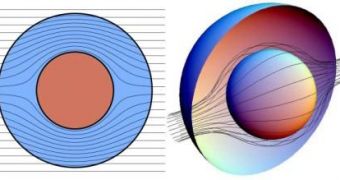The glass or plastic lenses in your eyeglasses redirect, or bend light into the right direction to focus it when your own eyes are no longer capable of doing so.
When looking through a lens that is not fitted to your eye, the image looks distorted to a small angle, exactly like looking at a straw emerged half way in water that looks like it's broken.
That is because a light ray striking the surface of the water at a 45-degree angle from the right bends farther downward into the water and continues to travel down and to the left.
But if you replace the water with a "left-handed material", the ray would bend so much that it would travel down and to the right instead, so the straw will appear not only to kink, but to bend back under itself.
This is called negative refraction and it has been demonstrated for microwaves using a specially designed material that consisted of small c-shaped rings and little rods.
The first superlens with a negative refractive index provided resolution three times better than the diffraction limit at microwave frequencies at the University of Toronto.
To bend visible light the "wrong" way, physicists Henri Lezec and Jennifer Dionne, of the California Institute of Technology, employed a new material, a sandwich-like arrangement of a 50-nanometers thick layer of insulating silicon nitride between silver on top and gold on bottom, to produce negative refraction.
When light waves zip up along between the layers, they stir up ripples in the electrons at the metal-insulator surfaces called plasmon polaritons that carry the light until it emerges from the other edge.
But when the light waves have the right frequency, the ripples in the plasmon bizarrely run upstream against the flow of the light, thus producing negative refraction.
The choice of these precious metals is due to the fact that, unlike almost all materials encountered in optics, such as glass or water, that have positive values for both permittivity and permeability, silver and gold have negative values at visible wavelengths.
These nanofabricated photonic materials, (metamaterials, a class of materials having properties not found in naturally-formed substances, but gained from their artificially created structure), have not only been used to create the first optical superlens, but have also been proposed as a mechanism for building a cloaking device by surrounding the object to be cloaked with a shell that affects the passage of light near it.
In fact, in early 2007, a metamaterial with a negative index of refraction for visible light wavelengths was announced by a joint team of researchers at the Ames Laboratory of the United States Department of Energy and at Karlsruhe University in Germany.
The continued researches may mean, in the future, that the "stealth" fighter will literally become the invisible fighter.

 14 DAY TRIAL //
14 DAY TRIAL //